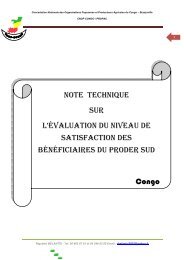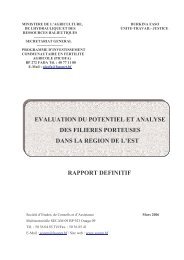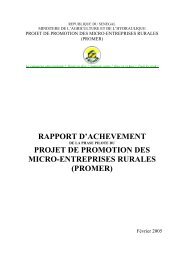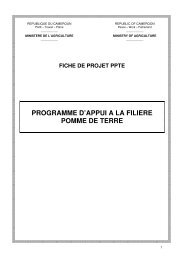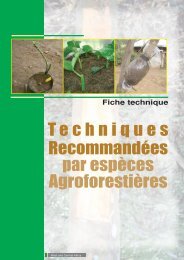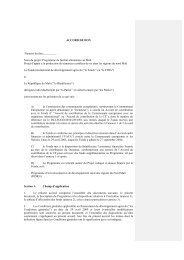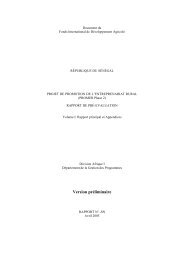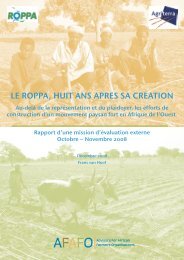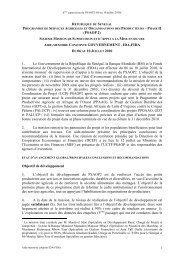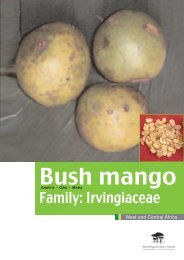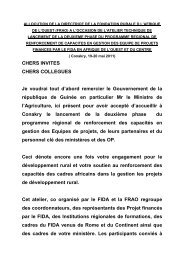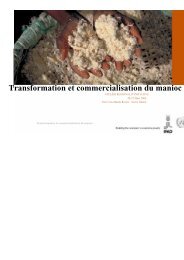Scaling Up the Fight Against Rural Poverty - FIDAfrique
Scaling Up the Fight Against Rural Poverty - FIDAfrique
Scaling Up the Fight Against Rural Poverty - FIDAfrique
You also want an ePaper? Increase the reach of your titles
YUMPU automatically turns print PDFs into web optimized ePapers that Google loves.
Chapter 5<br />
IFAD’s Instruments, Knowledge, Resources and Incentives<br />
for <strong>Scaling</strong> <strong>Up</strong><br />
This chapter pulls toge<strong>the</strong>r insights into a number of important aspects of IFAD’s institutional setup<br />
which affect its capacity to deliver on a scaling up agenda: IFAD’s operational instruments, its<br />
knowledge management approach, and its human and financial resource allocation practices.<br />
The analysis that <strong>the</strong> review team was able to carry out on <strong>the</strong>se issues was less detailed than for <strong>the</strong><br />
operational management aspects addressed in <strong>the</strong> previous chapter. Therefore, our assessment is more<br />
selective and preliminary. Conclusions and recommendations should be taken as tentative, with more<br />
in-depth and comprehensive analysis needed in a subsequent phase of work. Most of <strong>the</strong> evidence we<br />
have collected relies on interviews with IFAD managers and staff.<br />
A. IFAD’s operational instruments and modalities for scaling up<br />
IFAD has various operational instruments for engaging with countries and clients. In this section we<br />
briefly review a number of those that have special relevance for IFAD’s ability to help scale up<br />
programs for rural poverty reduction. We cover some of IFAD’s specific financial instruments and<br />
approaches, its engagement in policy dialogue, and its mechanisms for partnership engagement,<br />
including through co-financing and participation in sector-wide approaches (SWAps).<br />
1. Financial instruments<br />
IFAD has various ways of employing its finances that can support a scaling up agenda:<br />
Topping up: This is a way for IFAD managers to add resources to a project that can absorb more<br />
money than originally planned. 29 Topping up can be a useful way to expand <strong>the</strong> scope of a project, but<br />
unless part of a well-defined scaling-up pathway it will not amount to a serious scaling up effort.<br />
Repeater projects: A repeater project replicates, extends or scales up a successful project. However,<br />
CPMs have tended to shy away from this practice, since <strong>the</strong>re is a requirement for a formal evaluation<br />
by IFAD’s Office of Evaluation of <strong>the</strong> original project, before <strong>the</strong> repeater project can be approved.<br />
This is seen as a time consuming process that causes serious delays for <strong>the</strong> follow-up project.<br />
Therefore, CPMs have preferred to modify <strong>the</strong> original project to avoid <strong>the</strong> formal designation of<br />
repeater project, even when de facto a follow-up project was intended. The more appropriate<br />
alternative would be to build an evaluation process from <strong>the</strong> beginning into <strong>the</strong> implementation of <strong>the</strong><br />
original project that would allow timely results to be available at <strong>the</strong> time of completion.<br />
Flexible Lending Mechanism (FLM): In 1998 <strong>the</strong> FLM was introduced as a way to give IFAD and its<br />
borrowers a longer term and more flexible instrument for engagement. 30 The instrument appears to be<br />
29<br />
Topping up is used especially towards <strong>the</strong> end of replenishment phase when IFAD has to use its resources on a<br />
use or lose basis.<br />
30<br />
The FLM policy document describes <strong>the</strong> instrument as follows: “The main elements of <strong>the</strong> FLM include longer<br />
loan periods (10-12 years as opposed to <strong>the</strong> typical five-to-six-year loans); a clear articulation of long-term<br />
38



